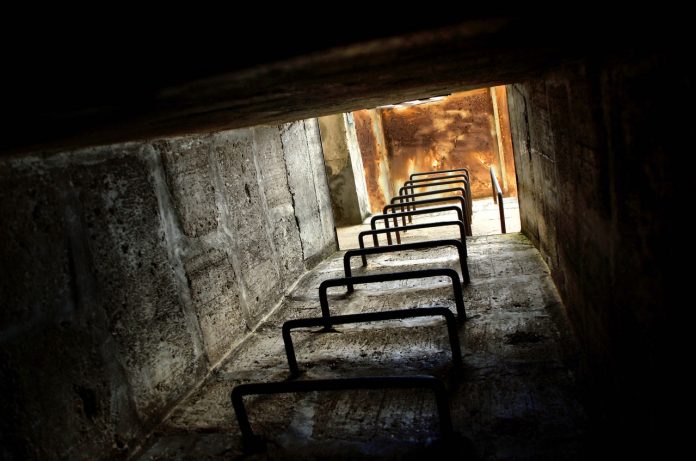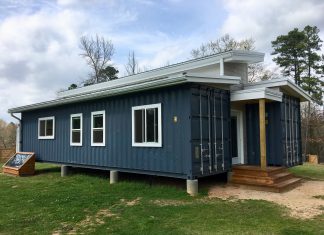BUNKERS! The ultimate survival shelter! Or are they!? Are underground survival bunkers good or bad for real-word survival scenario? We all know why they’re built, but are they realistic survival shelters? Underground bunkers aren’t for survival against an invasion attack from enemy combatants…they’re designed to keep you alive during a surgical strike, bombing, or nuclear warfare/fallout…or a wind storm (tornado) type natural disaster. Survival bunkers are not designed for floods…you’ll drown unless you have a way to deal with water and pump it out of the shelter. Also..if it’s built right (it’ll seem counterintuitive) but bunkers are some of the safest places to be during an earthquake. Think about it. Think how bad the earth shakes with a bomb blast. That is exactly what bunkers are designed for.
Underground bunkers are not specifically designed to defend against enemy personnel/combatants or invasion. A bunker may be a BAD idea UNLESS they are secret and on HIGH ground and you have multiple escape routes and air vents/filtration systems. Like with basements and other underground constructions, you’ll need a sump basin and a sump pump with the assistance of a professional plumber so that collected water can be safely removed and avoid structural water damage. This article will go into detail about bunker construction, what a bunker is, what their purpose is and how to design your own survival bunker for maximum safety and security. Just in case you’re considering building your own doomsday shelter for the coming zombie apocalypse, nuclear war, WW3, civil unrest, or just to get away from the mother-in-law. You could always turn it into a man cave.

What is a Bunker?
‘A bunker is a defensive military fortification designed to protect people or valued materials from falling bombs or other attacks’. That’s Wikipedia’s definition bunker. The U.S. military definition of a bunker is ‘a heavily fortified, mainly underground, facility used as a defensive position; also commonly used as command centres for high-level officers‘. – Wikipedia

Types of Bunkers
Trench Bunker: Or PillBox, because it’s shaped like an old fashioned pillbox used to store medications. These bunkers are partially dug into the ground and is usually part of a trench system. These kinds of bunkers were used primarily during WW1.
Artillery Bunker: These types of bunkers can be found along coastal regions and strategically placed to provide maximum firepower and defense against enemy attack.
Industrial Bunkers: These are used for storage and protection of personnel against dangerous industrial accidents caused by rocket testing and other dangerous activities. They were also used by Germany during WW2 to protect sensitive information and industrial production from heavy bombardment.
Civilian/Personal Bunker: These bunkers have bunker design features that are suitable for food storage and storm shelters but can also double as an underground structure fortified against radioactive fallout. These kinds of nuclear fallout shelters were popular during the Cold War between Russia and the US in the 50’s and 60’s but fell out of favor over time as the Cold War cooled. Currently in 2018 people may see a resurgence in survival shelter popularity growth as the new Cold War heats up.
Fallout Shelter: “A fallout shelter is an enclosed space specially designed to protect occupants from radioactive debris or fallout resulting from a nuclear explosion. Many such shelters were constructed as civil defense measures during the Cold War.
“Shielding – A basic fallout shelter consists of shields that reduce gamma ray exposure by a factor of 1000. The required shielding can be accomplished with 10 times the thickness of any quantity of material capable of cutting gamma ray exposure in half…Usually, an expedient purpose-built fallout shelter is a trench; with a strong roof buried by 1 m (3 ft) of earth. The two ends of the trench have ramps or entrances at right angles to the trench, so that gamma rays cannot enter (they can travel only in straight lines). To make the overburden waterproof (in case of rain), a plastic sheet may be buried a few inches below the surface and held down with rocks or bricks. Blast doors are designed to absorb the shock wave of a nuclear blast, bending and then returning to their original shape. – Wikipedia
Climate control – Dry earth is a reasonably good thermal insulator, and over several weeks of habitation, a shelter will become dangerously hot. The simplest form of effective fan to cool a shelter is a wide, heavy frame with flaps that swing in the shelter’s doorway and can be swung from hinges on the ceiling…Unfiltered air is safe, since the most dangerous fallout has the consistency of sand or finely ground pumice. Such large particles are not easily ingested into the soft tissues of the body, so extensive filters are not required. Any exposure to fine dust is far less hazardous than exposure to the fallout outside the shelter. Dust fine enough to pass the entrance will probably pass through the shelter. Some shelters, however, incorporate NBC-filters for additional protection. – Wikipedia
NOTE: A fallout shelter is not the same thing as a bunker. A bunker can act as a fallout shelter, but they are built differently and have different primary purposes.
Military/Storage: Militaries throughout the world use bunkers to store munitions and vital equipment and materials necessary for strategic defense.
Bunker Defense and Protection
Now that we’ve talked about what a bunker is and the types of bunkers found throughout the world let’s talk about defense and protection.
- Blast Defense: A bunker’s primary purpose is to protect it’s occupants against explosive blast and the concussive wave and from munitions/projectiles like artillery shells and bullets.
- Radiation/Fallout Protection: Second, bunkers are designed to protect against radioactive fallout from nuclear weapons attack. Depending on how thick the walls, ceiling, floor are and how much overburden (soil/dirt/rock/gravel) cover the bunker and how close a nuclear blast is from the bunker’s location will determine how “survivable” a bunker’s construction is. No bunker is complete without a properly built air purification and filtration system or it’s pointless.
- Chemical Attack Defense: With proper filtration systems in place with redundancies built in a bunker can provide a safe place to wait out a chemical attack as well.
- EMP (Electromagnetic Pulse Attack): Technically speaking you don’t need a bunker to protect yourself from an EMP attack because it won’t hurt you, just your electronic equipment and then usually only when it’s on. Depending on how far you are away from the EMP’s epicenter that will dictate how strong the pulse is and how much damage it could do to your electronics like computers, cell phones, modern vehicles, or any electronic device like CB radios, HAM radio, or any device that uses electronics. If properly built your bunker can withstand an EMP easily. A simple Faraday Cage will work. The steel reinforcement within the concrete walls should provide some protection, however, you should think about adding a copper mesh either around the outside or on the inside surface of the bunker to shield against electromagnetic interference. Keep in mid however…any electronic communication equipment will not function inside the Faraday Cage.
- Frontal Attack or Invasion Defense: A bunker can provide some protection from invasion or attack from enemy attack if it’s equipped with artillery or extra-defensive measures like booby traps, security systems and trained personnel. However, having said that, that it not a bunkers primary purpose. They are designed to protect against blast and radiation, not a direct attack by enemy combatants. A surgical strike force by special forces or highly trained military or ex-military personnel could infiltrate any structure given enough time and resources. So keep that in mind and always leave yourself an out. You must have an escape route.
Flooding: Flooding it seems is on everyone’s minds. People are afraid of being trapped inside a flooding bunker and that’s a well placed fear because it could happen if you don’t build your bunker to handle flooding. Let’s be clear, flooding will kill you if you’re caught in it and you are not prepared. Build on higher ground above the flood plain if possible. 10′ above the flood plain should be adequate for all but the worst possible floods. If this is not possible for your area don’t worry, you can still have a bunker, you’ll just have to build it like a ship with water tight doors and hatches, which it should already have to begin with to keep out contaminants, gas, and radioactive fallout. You’ll also have to install water pumps as a backup measure and that will take lots of power. If you build your bunker above the flood level say into a mountain side then flooding most likely won’t be an issue. Those folks who live in lowlands might want to consider backfilling their property if it’s not illegal to do so, and raise the land up around the bunker, effectively burying it above ground level but under a giant mound of earth. This might not be practical for a stealth or secret bunker location because it will look out of place and in a survival scenario someone will eventually figure out that there might b something of value under that mound. Some companies do make survival pods for low lying flood prone areas which are basically a steel tube or a sphere that is water tight and it floats and can be chained to the ground so it doesn’t float away during a flooding event. But that’s not a bunker an we’re talking about bunkers. In low lying areas with water just below the surface a bunker is probably not your best bet for survival, though it is possible, just like build a swimming pool in Florida, it can be done, you just need to get the water away from your bunker and install proper drainage systems.
Emergency Escape: Always have a way out. Multiple escape hatches are a good idea in larger bunkers, just keep in mind for every escape hatch you build into your bunker that poses a security risk because each way out is also a way in. Proper security measures must be taken to secure the bunker from outside attack and infiltration. Having said that, if you’re a clever person and you know how to build things you can build multiple escape hatches into your bunker in strategic locations. You can have multiple hatches in a larger bunker, not the little pods and concrete culverts or plastic dome shells you cover with dirt. Those aren’t bunkers they’re fallout shelters posing as bunkers. A bunker is a fortified structure usually deep underground. It’s large, perhaps as large as a home and it has multiple escape routes, tunnels and backup systems in place for emergencies. If you’re smart and you understand the importance of a bunker in a survival situation then you’ll build into that system a ways to escape. When would you need to escape and leave the safety of a bunker? When it’s no longer safe of course! When is that? When there is a danger that compromises the bunker. A force of many enemy combatants or a gang of thieves or rioters could corner you in a bunker and your bunker then become a prison. If they get in and you have no way out you and your family are dead. I’ve heard horror stories of people hiding in their basements during civil unrest in other countries and they ended up dead because they had nowhere to run to. The basement turns into their coffin. I’m not saying this to scare you, but to make you aware that a bunker is only as good as it’s design. If you design it with no escape then you’re asking for trouble. Always always ALWAYS have multiple escape routes and hatches built into your system.
AUTHORS NOTE: I’m amazed at the ignorance of some people who cannot think of this very simple and vital aspect of bunker design and construction. They are so narrow minded and short sighted that the moment you mention the word “bunker” they automatically assume you’re referring to a tiny little backyard bunker that could flood in an instant and leaves you no out in case of attack. No! Those aren’t bunkers, they’re coffins! This article is about solid, well engineered, well built bunkers with flood control, fire control, air filtration systems, radiation and EMP/Electromagnetic shielding, blast proof, earthquake proof, bunkers. A bunker is about survival, and escaping the dangers of natural disasters, civil unrest and war. Bunkers are no joke. They’re the most fortified structures in the earth. They can withstand just about any punishment you can throw at them and protect it’s contents leaving everything safe and sound. This means you and your family and friends if you choose to have them in your bunker too.
Secret Hidden Bunker or in Plain Sight?
Now let’s talk a little about whether or not you build your bunker hidden or make it obvious there’s a defensive structure. This is a highly controversial topic because everyone has an opinion on it.

Do you build you bunker deep underground, partially buried, atop a hill in plain sight for the world to see?
This is probably a debate that will go on for as long as people exist. I’m not sure there is any single correct answer to this question because there are so many variables to consider, too many possible survival and attack scenarios, and a billion more opinions that everyone seems to want to share. So, I’ll share mine.
I don’t think there is any single bunker type that is good for all survival scenarios as any bunker will have its strengths and weaknesses, and given enough time and training and resources anyone can get into any structure. That said, this is about willpower and determination as much as it is about bunker construction.
You can have a bunker that’s 100 feet below ground (think old military missile silo converted into a modern day off grid bunker). Or you can build a tiny little backyard bunker from a concrete culvert buried 10 feet below the surface, anything in between. I personally would build my bunker…Nevermind. I can’t tell you that. Part of OPSEC rules. If you don’t know what OPSEC is it basically means you don’t tell people about your security…because that’s a huge part of security.
“Operations security (OPSEC) is a process that identifies critical information to determine if friendly actions can be observed by enemy intelligence, determines if information obtained by adversaries could be interpreted to be useful to them, and then executes selected measures that eliminate or reduce adversary exploitation of friendly critical information. – Wikipedia
In other words, don’t go blabbing to the world about your bunker or what you have to defend it. Keep it secret. Let me be clear. This is imperative to your survival. Never let anyone know your defenses. Technically if they are smart they can figure it out anyway, and they probably will, but you don’t want to help your enemy destroy you or your family. Keep that in mind. I see too many people bragging about their security and what they have and I just shake my head at their stupidity and ignorance. They let their pride and their want to impress people get in front of their priority to protect themselves and their families from harm.
It’s foolish and if the world ever does go to sh*t and the SHTF, the those people will be the first to be gone because there are people like me who will exploit their weaknesses. In a survival scenario it’s you or them. Just understand that there are lots more people out there that will too. They are willing to do anything to survive. They will destroy anything and they will exploit any weakness possible. It’s best not to help them. This is why if I do have a bunker no one will know I have it. It will be in a secret place and it will not be visible or obvious from the ground or air. There will be no sign it’s there. It will be invisible.
A bunker built in plain sight could be just as good as a hidden bunker, but in my opinion keeping it secret adds another layer of security and that could be the difference between life and death. This is about survival, so it’s a no-brainer.
Bunker Security
Build a bunker and tell no one about it. Not even close family. Seriously! Don’t tell them! This is about security. You cannot control what someone else tells someone but you can control who you tell about your bunker. If you tell no one then you can control the information. Intelligence is keeping secrets. Don’t be tempted to tell anyone outside your spouse or kids and you should be very careful about telling your own children. Why? Because kids talk. They brag and they try to gain acceptance into little cliques at school. You don’t need word getting out that you have a survival bunker in your backyard. (also, you might consider an offsite bunker/bug out location). You love your children and your spouse, and of course you trust them. But if you love them you will not tell them about the bunker unless you are 100% sure they can keep a secret and not betray the family trust. It’s not that they will do it on purpose. They could accidentally disclose the existence and location of the bunker to their friends and we all know how that goes. There are different levels of friends and the existence of a bunker will be remembered in a time of crisis. That “friend” during peacetime can quickly become an enemy during a survival scenario.
This is why you tell no one. This might be hard if you have to hire a contractor to build it for you.
BUILDING OFFSITE FOR INCREASED SECURITY: I would advise you to hire a licensed contractor and engineer to build your bunker for safety reasons. And if possible for an added level security however, have it built offsite…then go pick it up and install it yourself at your secret location. This way you decrease the risk of revealing the location of your bunker. This might seem extreme but security is paramount and you should do everything in your power not to reveal the location of your bunker to anyone. That includes your builder/contractor. Remember this is about survival. In peacetime everyone is your friend…in a survival scenario, not so much. This means learning how to install a bunker yourself which means learning how to operate heavy equipment. You’ll probably need to know how to operate a crane, and an excavator, frontend loader, and probably a backhoe. If you work in construction and already know how then you’re one step ahead of the game. You’ll also need to know how to drive a big rig tractor trailer, most probably a flatbed. This is for when your contractor is done building your bunker. If possible use a tarp or enclosed trailer to prevent prying eyes from seeing what you’re carrying when transporting your bunker to your secure location. The reason why it’s called a “secure location” is because no one knows about it! If you don’t care about security then go ahead and hire a bunker builder contractor to build your bunker onsite. Sign their little “secrecy agreement”, then after the Zombie Apocalypse happens and that contractor’s customer database is compromised and him or his workers remember where they built your bunker you’ll probably have visitors. OPSEC!
Fight or Flight?
Do you bug-in or bug out? That is the question. Do you shelter in place or do you head for the hills? If you have a good strong bunker built then the answer to that question is pretty simple. You shelter in place and fight it out if someone comes along and tries to get in. If you’ve prepared yourself and your bunker you should be able to defend against almost any attack. Just keep in mind there are always people and groups of people who will be more highly trained than you and have more resources. A siege is a real possibility. Do you have enough supplies to last a prolonged siege if your enemy decides to starve you out. This was common back in the middle ages during wars. Prolonged attack that lasts weeks or months at a time could starve you out and then you and your family are dead anyway. Or if you didn’t prepare your bunker properly with the proper filtration system and air intakes your enemy could simply gas you out by using your ventilation system to pump some poison noxious gas into the bunker forcing you out into the line of fire.
Direct Attack: You most likely won’t have to worry about a direct attack by a bunker busting bomb dropped during a surgical strike by a military force because you’re most likely not a threat to any government. If you did you’d have to build your bunker 1000 feet below ground level and beneath a mountain because militaries today have massive bunker busting bombs/missiles that penetrate hundreds of feet below ground to obliterate their targets.
WW3, Zombie Apocalypse, Nuclear War!

In case of war, whether national, worldwide or localized in a state or region a bunker can and will provide good protection against just about any kind of attack. It’s advantages outweigh it’s disadvantages.
The Key to Survival in a Bunker
It’s all about time. A bunker keeps you and your family safe and alive longer than if you were exposed on the surface or in a residential home or commercial building. The dangers are many but if you plan right, prepare, and build your bunker to withstand everything except a direct military attack you should be safe against any threat that any civilians could muster against you. A well built strategically placed secure survival bunker buys you time by protecting you against the threats that war and natural disasters and people pose.
Let’s say you spend the time and money necessary to build your own survival bunker and you make security your top priority next to the bunker construction itself, you should be able to survive anything the world can throw at you. So to answer the question in the title of this article.
YES! An underground bunker is absolutely a good idea for survival in just about any survival scenario if you design and engineer it properly.
So…Are you going to build a bunker?
Think OPSEC!
***
Did you enjoy this article? Please consider linking to us and follow us on social media for more information off grid and survival related news and educational information.
Thanks!
OGS















[…] like the CyberTruck even at first glance. While they are touting it as a “Zombie Apocalypse” survival bunker, the design should also withstand a natural disaster such as a […]